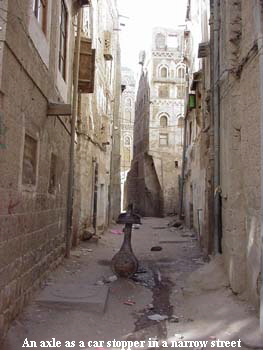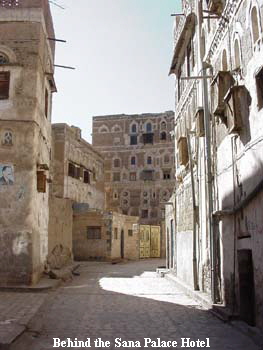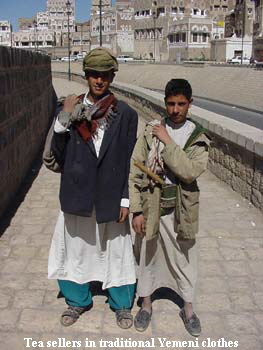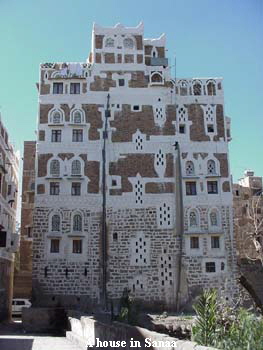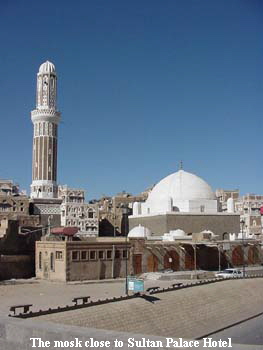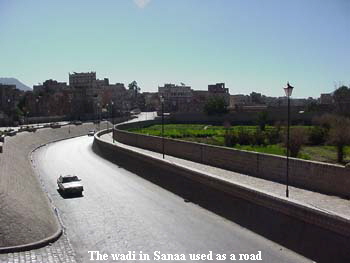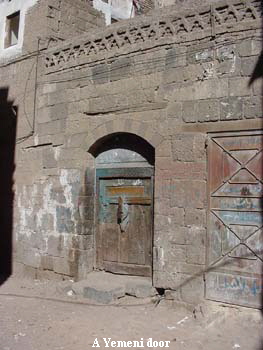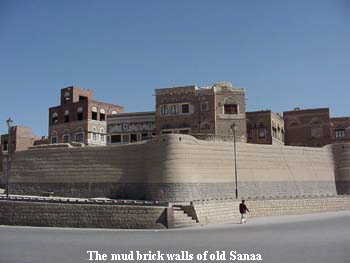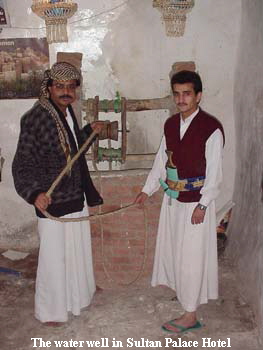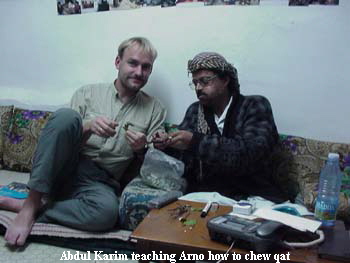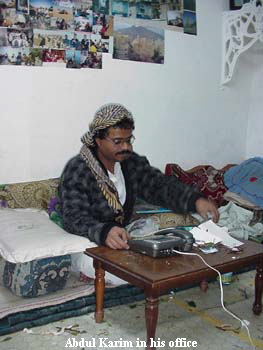 |
|||||||||||||||||||
|
|
|||||||||||||||||||
|
Last update: Monday, September 05, 2005 |
|||||||||||||||||||
 |
||||||||||||||
 |
||||||||||||||
|
|
||||||||||||||
|
Women were completely veiled in black robes leaving a 'tank' style opening round the eyes, sometimes even having their eyes covered by a black coth too. We noticed many people looking at us. When we returned a look we got a smile back almost immediately. Our first impression of the Yemeni People was a happy one. Men and children walked the streets with happy faces, and with no doubt the women too although we couldn't see their faces.
Everywhere we looked we saw children playing on the streets, sometimes approaching us to try out a few English words. A few kids kept themselves busy by selling candy and water bottles in very small "closet"shops located in a house or just a plain wooden box on the streets. Somehow the kids playing in the streets remembered us of our own childhood. The happy athmosphere simply radiated from their play! Powerfull childhood flashbacks raced through our minds, reminding us how little kids need to be utterly happy. The toy saturated 'Nintendo' society back home felt like something essentialy important had evaporated silently in the years of prosperity and progress. At some point we noticed that the pace on the streets increased, some men started running and streets were suddenly becoming empty. We didn't notice this at first because we were somehow assuming the running had to do with the approaching sunset. However at the first blast of the call for prayer from the many mosque's in Sanaa we knew what was happening. The evening prayers at the Mosque!
A little while later people re-appeared on the streets carrying food still almost running. Having eaten nothing the whole day, we could imagine the rush of the people around us. We saw many small groups of men squatting in the streets around big metal plates filled with food, eating quickly. At two occasions we were asked to join, a custom we later learned is closely related to the generous hospitality of the Yemeni people. It was difficult for us to refuse the offer, knowing that it's almost like an insult not to accept. However on our first day in Yemen we didn't feel that confident to just squat down too and join the eating in the streets.
Returned at the Hotel we were invited to join dinner again with the Hotel staff in the living room . We looked at each other not knowing what to say, stunned by the generosity. This time we accepted although we didn't feel hungry at all. Within 10 minutes we sat of the floor around a huge dish of food trying the traditional Yemeni dish called 'Salta'. Dipping freshly baked 'gobs' (huge round pieces of bread) into the 'Salta' we experienced the communal feeling Yemeni people radiate while eating. During the obligatory tea after dinner we told a little about ourselves and our trip through the Middle-East. We were asked a few questions about life in Iran, Syria and Jordan and what we thought about Yemen so far. "A country with the most friendly customs officers of all Middle-East countries we visited", we answered referring to our past border crossings and not knowing what to say more after only 12 hours in Yemen.
At some point we followed a discussion about the purity of Islam in Yemen. The Ramadan in Yemen is practised in full causing many businesses to on half the manpower. Working about 4 hours a day seems to be normal in Yemen during Ramadan. The opinions were diverse, some thought that this affects the economical position of Yemen. Others expressed that joining Ramadan in full simply can not be combined with the same hours of labour outside the vasting period. One point everyone agreed upon; Yemen is a country where the Islam is practised in freedom and where many religious customs are still pure and untouched by western influence. If people choose to join Ramadan, than so be it. Working 8 hours a day without water and food during daytime is hard on everyone, working less seems to be the only alternative. Still tired from our flight and all the impressions of our first day in Yemen we left for bed early. Our first day impressions of Yemen were good, we could only look forward to learn more about this fascinating country.
The next two days we walked through Sanaa exploring the old city and the newer Sanaa behind the central post office. Although many shops were closed during the day because of Ramadan we enjoyed the city very much. The 3rd day we explored the city in the evening knowing a few reference points from our walks during the day. The city comes to life after sunset during Ramadan, shops are opened and everywhere we saw busy trading. While exchanging a few traveler cheques at a bank we were baffled by the sight of a man filling a huge duffel bag with packs of money. Even bystanders helped him pack money into his huge bag, all looking very confident to get the huge pile of money on the counter into the bag. This scenery simply looked impossible to us, no one in his right state of mind would dare to walk the streets with so much money on him. But then again this is Yemen, theft is almost non-existent unlike the world we normally live in. But walking the streets with such a pile of money, like it's a bag of bread or hay, looked insane to us. While stuffing our insignificantly small pile of money in our hidden pouches under our clothes we watched the man leave the bank with his bulky bag of money almost having to drag it over the ground. No one around him even blinked, a normal sight and apparently no problem. Having a trip in mind through the south of Yemen we started to make a few inquiries around us. We quickly learned that we needed travel permits for every move we made in the country. Getting the permits didn't seem like a big problem, they're free for independent travellers (not for tour operators). But getting passed the many checkpoints in the country was the biggest challenge. We heard stories about being send back when trying to move around in service taxi's or small busses. But then again most of these stories were about the Sanaa region. Getting out of Sanaa on your own using public transportation seemed impossible. Ofcourse a thing which happens to be very convienient for the many tour agencies, what's better than having the army supporting your business? The only reliable way we heard of to get through the many checkpoints was getting a seat on a bus of the (privately run) Yemenico transport organisation to for instance Aden. But then again we would be rushed passed many points of interest without having the chance to actually see it properly. The alternative was to join a tour group or renting a car and driver through a tour organisation to be able to explore the country in more detail. Looking at the travel permits, we had to come up with a detailed initiary stating which day we stayed where (which Hotel) using what transportation to get there. We knew that we would probably violate any initiary after a single day, for instance not staying in the Hotel we promised to stay in, or even not making it to the city stated in our travel permit. Undoubtedly this would raise questions at the many checkpoints, making the passing of a checkpoint a time consuming business.
A bit troubled by travel permits and the checkpoints we had to weld our travel plans for Yemen into a different form. Full independent travel seemed simply impossible at this moment of time. Reading our Lonely planet we could not find a word about the travel permits and the travel difficulties we just learned about. The stories about these new regulations were undoubtedly true since we heard them from a few independent sources. However the travel regulations seemed more rigid in the north and western part of Yemen and around Sanaa. Later we discovered that permit regulations have changed since the start of 2000. Roughly speaking, the new regulations forbid any tourist to make their own tour without signing up with a tour operator. Looking at this from the government side, it's a way to protect Yemen from western influences and along the way they have an eye on who's traveling where (in case of a kidnapping?). The tourist agencies will see their sales go up a bit, however the majority of tourists already book their tours with agencies at home. The bad part to us is that most of the cash tourists bring in end up in the pockets of the happy few. On the 4th day we started making inquiries at the many tour operators in Sanaa. Some of them came up with a joined group tour, starting at the day a group arrived from some country. But all offered a car with driver for a private tour ranging from 50-90 US$ each day depending on the difficulty and destination of the tour. When exceeding approximately 6 driving hours, a double day is charged, doubling the daily rate for a particular stretch. The hardest part in the tour we had in mind was trying to cover the Sayun-Marib desert stretch without paying a 200-250 US$/car 'Bedouin escort tax'. The tax is collected by Bedouin people at the start of the desert stretch and provides for protection and guiding through Bedouin desert land. Being catapulted through the desert in a 4WD with an armoured bedouin escort in one day (it's a 450 Km drive), while having to unload a huge amount of cash sounded so contradicting. But for only 50 US$! more we could stay in the desert for one night we were told at two separate occasions. We know that the Yemeni government doesn't have much influence in the desert region, it's Bedouin country after all. It's like the Indians of the America's or the Aboriginals in Australia, except the Bedouin in the Yemeni desert still have considerable self-control over land and people. So Yemeni oil companies in the desert pumping oil from Bedouin land have caused many (violent) disputes in the past. Also tourist organisations bashing large groups of tourists over Bedouin land are subject to their laws, and consequently paying dearly for a passage through the desert. In fact many tour operators have contracts with the Bedouin people, promising to incorporate the Bedouin route in their initiary if they want to take people through the desert. One aspect of Bedouin people is that they highly value their solitude and independence. They are awkward towards large parties crossing their land, possibly seeing them as a threat to their people, violating culture and customs. Groups of tourist might form the ultimate (future) threat, massively stepping on valuable and very old customs like the famous Bedouin hospitality. The Bedouin who shot his own horse to be able to feed his guests is a reminder of how these desert people think. The customs work for strangers coming in small groups so now and then like in the old days, but not for large tourist groups showing up day after day. Later we learned about a new (1 year old) asphalt route connecting Sayun with Marib. A route undoubtedly having caused many disputes with Bedouin people also. The route wasn't on our Freytag & Berndt map (print Jan 97) but later we discovered than the new version of the map does show the new asphalt route. It seems that the border with Saudi is also shifted north, because the new route crosses the Saudi border on our older map. With this route in mind we asked around again. Some tour operators even denied the existence of the route and others came back on their contract with the Bedouin people only offering desert initiaries with the Bedouin route in it. The bus company Yemenico also operates busses on this route but doesn't take foreigners because of shooting accidents in the past. While asking at our Hotel about the possibility of taking the Sayun-Marib asphalt route we got the response 'mush-mush kila' meaning 'no problem'. They could also arrange a driver willing to take that route and thus avoiding the desert and Bedouin tax. Thinking about this offer more closely we realised that we would be taking a considerable risk. Any driver can always back out on taking the asphalt route on the spot for whatever reason, thus leaving us no option to backtrack or take the expensive Bedouin desert route. We decided to leave our frantic trip planning efforts for a while and see what else comes around. That evening we were invited by the reception manager Anwar to chew qat with Abdul Karim and Mr. Ali, the owners of Sultan Palace Hotel. Ofcourse an offer not to be taken lightly so we joined in curious about this qat chewing thing. Although it's Ramandan qat chewing continues normally, however the socialising begins only after sunset (normally in the afternoon). 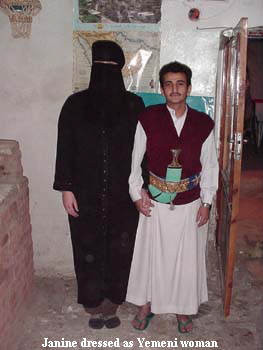 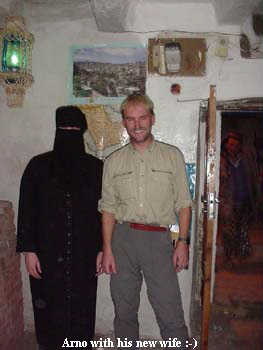
The first taste of qat is like chewing freshly cut green grass, it's bitter, crisp and a bit difficult
to keep it between cheek and jaw. We both couldn't help swallowing the mushy remains of the first leaves but after a while we managed to keep a small bulky mass behind our jaws. We got
used to the taste but felt a bit like rabbits. We also started wondering what this qat chewing would do to us. While chewing many leaves we talked a lot about life in Yemen and the tourist business.
Yemen sees a fair amount of European tourists, in most cases arriving in tour groups of 15 -20 people. The groups circle the country in Toyota Landcruisers starting in Sanaa for 1, 2 or 3 week trips staying overnight in Hotels most of the time. German, Italian, French and Dutch groups are seen the most, groups of other nationalities seem to be a bit of an exception. The groups are easily spotted, a rushing line of 4-5 Toyota Landcruisers is unmistakingly a group of tourists being rushed through Yemen. We haven't met many independent travellers, it seems to us that most people choose to visit Yemen as part of a group or some kind of prepared arrangement. Camp trips are on the rise but this is a bit of a new concept to Yemeni people. There are no (commercial) campsites (yet), so all camping is in the wild and so far as we could find out in most cases organised by a tour organisation. Next to the 'normal' tourist activities there are a few people bashing the countryside with mountain bikes, paragliding the skies or backpacking through (for instance) the Haras mountain area. After 2 hours of chewing qat we didn't feel any different and wondered if there is some kind of a suprise waiting. Well there was one, we hardly couldn't sleep that night. Qat is a light drug and fits into the category of coffee. Yemeni people chew qat to keep on going without much sleep or to fight the cold in winter time. Next to all this, chewing qat gives you a sparkling green smile and a big trumpet players cheek. But most of all, qat is a social 'drug'. Before we turned in for the night, Anwar the reception manager of Sultan Palace Hotel invited us for a afternoon day tour the next day to Bayt Baws, a small mountain village on top of a mountain just outside of Sanaa. Without hesitation we accepted his offer, and looked forward to seeing this place. After a sleepless night we continued our search for affordable private transportation through the south of Yemen in the morning. Joining a tour group didn't seem the right thing for us after having travelled independently for months. Trying to use public transportation felt like a highly uncertain way to get around considering the relatively high chance of being send back at the many military checkpoints. Going through the different car/driver quotations of Yemeni tour organisations we found them all a bit on the expensive side. At least 60 US$/day without having bargained for a better price. Asking at a car rental company (Europcar) for a (new!) Toyota Landcruiser we were offered a price of 87 US$/day (with basic insurance only) for a one week rental period. Way too expensive compared to 60 US$/day for a 4WD with driver! Asking at the Hotel staff we were offered a Toyota Landcruiser with driver for 50 US$/day, which sounded a bit more affordable. Also taking in account that fuel, food and overnight expenses for the driver are included. On top of that we had to buy our own food and pay for the Hotel expenses. Compared to European standards this sure is a bargain. Going through our initiary with Mr. Ali and Anwar we came down with a 9 day tour of approximately 1500 Km's including two days camping in the wild and excluding the expensive Bedouin desert route. The latter we considered as a bit of a risk in our tour, we didn't know for sure if the driver would go for the Sayun-Marib Asphalt route. So we decided to take the risk and agreed on booking our tour through the South of Yemen at the Sultan Palace Hotel starting at Monday 25 December 2000. To us it was the best deal we could get after a few days of inquiries.
With only one day left for preparing our roadtrip we bought some food and packed our backpacks again. For the 2 camping days in our tour we could use the small tent supplied by the Hotel, our driver would be sleeping in his car we were told. We felt a new episode in our 6 month Middle East journey was about to start. After 4 days of Sanaa and having acclimatised a bit we felt ready to see more of Yemen. Late that afternoon we joined Anwar for a small tour to Bayt Baws on the outskirts of Sanaa. We stepped into several very small Suzuki busses, having our legs cramped into our necks. Normally 8 Yemeni people can fit in there, but with us two the small bus was full with 4 people. For the last stretch to Bayt Baws we stepped into a 'run down to bone' Opel Ascona Stationwagon luckily not going faster than 50 Km/hr. When the driver turned into a dirt road the whole body of the car seemed to come alive. The car squeaked, grunted and literally bended under our feet. Looking at the steep rocky road ahead we immediately had serious doubts if this car would make it up there. Not to think about if we would get alive on that steep hill. Luckily the driver stopped just before the road got real steep. The brakes squeaked hard, producing a metal on metal sound. While the car rolled slowly backwards we could exit and pay the driver for bashing his car on the rocks a little more. Continuing on foot, guided by Anwar, we reached the stone walls of Bayt Baws after 30 minutes of climbing a rocky trail. The old town is practically in ruins, only providing shelter to a few families. In the old days many Jews lived in Bayt Baws and we could spot a few signs of their past presence. The place sure is worth a visit, it provides a stunning view over Sanaa and with the approaching sunset, being there is a breathtaking experience. 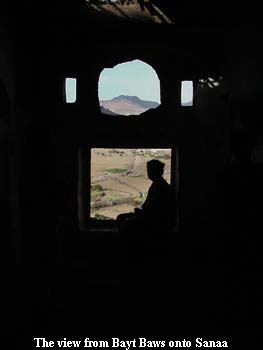 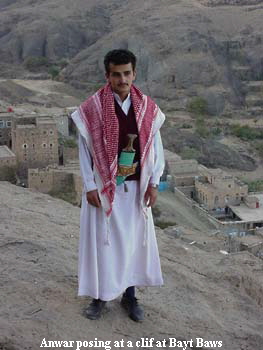
|
||||||||||||||
